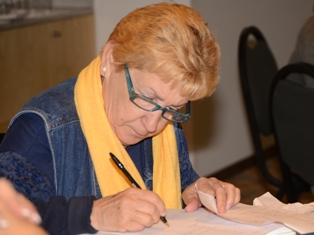 Hi Elaine,
I am writing you from _____ because we teachers are having some end-of-term meetings and we were really concerned about some issues.
We are worried about grammar accuracy in our new CLIL philosophy system. In our opinion, most of our kids are learning and having fun, but they relax too much in verb tenses or word order with the result of many important mistakes which can even affect normal communication.
We would love to be guided around the world of introducing grammar accuracy while we are not teaching grammar. Do you have any advice or technique to help us? Your help would be really appreciated.
Thank you,
Alberto.
Hi Elaine,
I am writing you from _____ because we teachers are having some end-of-term meetings and we were really concerned about some issues.
We are worried about grammar accuracy in our new CLIL philosophy system. In our opinion, most of our kids are learning and having fun, but they relax too much in verb tenses or word order with the result of many important mistakes which can even affect normal communication.
We would love to be guided around the world of introducing grammar accuracy while we are not teaching grammar. Do you have any advice or technique to help us? Your help would be really appreciated.
Thank you,
Alberto.
_____________________
Dear Alberto,
Thanks for the question. It’s a good one and a cause of concern to many English teachers who also want to support the CLIL philosophy.
The two are not contradictory. Please share my responses with your English coordinator and the others at your school. Also feel free to share the attachments I am sending.
CLIL does not say that we should not teach grammar at all.
CLIL supports grammar teaching after the students are using specific verb tenses, with a bit of fluency, but, yes, with some errors.in other words, teach grammar in context.
1. If you hear students making errors in verb tense (the most common grammatical error), correct them orally, in a subtle way, by repeating what they said, but using the correct verb.
If a student says:
I go to my grandmother’s last night.»
Repeat…»Oh, you went to your grandmother’s last night.» the student should then (hopefully on his own), say, «yes, I went to my grandmother’s last night.»
2. If you see a mistake that several students are making, stop the class and tell them you need to interrupt with a «mini-grammar point». Then explain the error, show the correct form, and have students repeat and copy the mini-lesson in their notebooks.
3. If the kids are needing to use past tense, it’s time to teach lessons on past tense. Students can repeat orally, and then copy examples in their notebooks.
4. there are many fun apps using grammar games. I can send you a list if you want some.
5. The major point in CLIL is that the emphasis is on fluency not grammar, but teaching grammar in context, pointing out examples, giving mini-grammar lessons, and practicing the correct format are ways of teaching grammar in a subtle way.
You can still emphasize oral production, fluency, fun and games, yet teach grammar incidentally; as a way for students to see that there are correct and incorrect ways to say/write things in English the same as in Spanish.
6. Your major goal should be that students learn by gradually practicing, and they’ll see/hear that things sound «right» or «wrong».
Example:
You was going there should sound wrong to your students.
You were going there should sound right.
Once they can identify what sounds right or wrong (by frequent oral practice and by teacher modeling), then give the students a mini-lesson on the use of present i am, you are, he is, and past. I was, you were, he was, etc.
7. I have attached several things:
(a) A grammar book I wrote (65 pages) it needs to be updated, but it’s a mini-guide of examples and grammar use;
(b) A list of grammar topics with approximate ages / grade levels when they should be introduced.
Please don’t emphasize grammar. We want kids to get used to correct grammar, but not fear making mistakes.
(c) 20 lessons, a course Ii wrote for Mexican public school English teachers who needed more grammar work to support CLIL, gradually working on grammar points, with sample activities for practice.
These things are not to replace your own fun/games/activities/topics. They are to support you in a gradual grammar approach.
Please let me know, Alberto, if you need anything else or if you have any questions. I am at your service.
A big hug,
Elaine
________________________________________________________
Readers:
If you want any of the mentioned attachments, write to me (juniorbarney1@yahoo.com) and I’ll send them to you. Elaine Gallagher